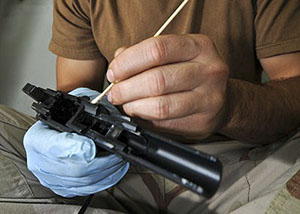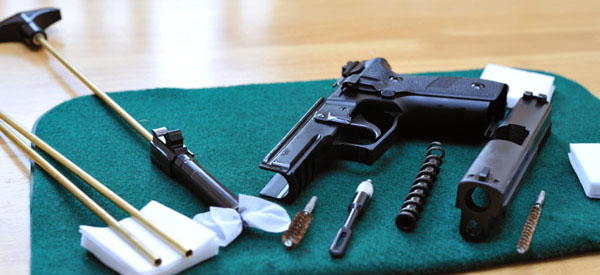It doesn’t matter how good your gun is if you can’t keep it clean. With every shot, propellant residue collects in the working parts and traces of the bullet collect in the rifling grooves. Over time this builds up and eventually it will compromise the effectiveness of your weapon. Carbon fouling can cause stoppages, especially in a semiauto; fouled rifling will start to degrade the accuracy of your shots.
All guns sh ould be cleaned regularly whether they’ve been used or not, but while a wipe with an oily rag will deal with moisture and general dirt, it can’t get rid of the deposits left by each round you fire. To deal with those you need a good gun solvent. Unfortunately, these are expensive, and if you do a lot of shooting the cost can add up quickly. And what if the SHTF and suddenly you don’t have access to your friendly local gun shop’s range of solvents anymore? Sure, you can stockpile some, but eventually it’s going to run out. Then what are you going to do?
ould be cleaned regularly whether they’ve been used or not, but while a wipe with an oily rag will deal with moisture and general dirt, it can’t get rid of the deposits left by each round you fire. To deal with those you need a good gun solvent. Unfortunately, these are expensive, and if you do a lot of shooting the cost can add up quickly. And what if the SHTF and suddenly you don’t have access to your friendly local gun shop’s range of solvents anymore? Sure, you can stockpile some, but eventually it’s going to run out. Then what are you going to do?
Luckily it’s possible to make highly effective gun solvents at home, and they can work just as well as any of the commercial ones. Even better, it works out a lot cheaper. All you need are a few simple ingredients that can be picked up in bulk for not very much money. Here’s what you’ll need for a basic solvent:
- Auto transmission fluid. This is designed to keep your gearbox in running order. As well as lubricants (which are always good for guns) it contains a range of solvents designed to clear away metal particles, carbonized oil and a range of other nasties that tend to build up in the transmission – and although they have a different source, these contaminants are pretty similar to the ones that collect in a well-used gun. When you buy your transmission fluid look for one that’s labelled DEXRON II, IIe or III. It should meet GM Spec GM6137M, GM6417M or GMN10055; that will ensure it has all the solvents you need. Apart from that the brand you buy doesn’t matter, so just go for the cheapest one.
- Kerosene is another solvent, a more general-purpose one. Go for the grade marketed as 1-K heater fuel. You might also find 2-K kerosene, but avoid that if you can; it has a much higher sulfur content than 1-K. It will work in an emergency, but generally 1-K is much better. Also try to find the purest kerosene you can; it’s often dyed red for easy identification, but that just adds unnecessary chemicals to your solvent and some could remain in your gun after cleaning. Low-odor kerosene is also available and that tends to have fewer impurities, so get that for preference.
- Mineral spirits. This is good at dissolving old oil. It’s also sold as white spirit or aliphatic spirit, and you can find it in any hardware store for around $25 a gallon.
You’ve probably noticed that these ingredients are all volatile, flammable and not great things to have on your skin in large quantities. Now that you have them don’t just start mixing them on the kitchen table; you need to take some basic safety precautions. First, find a well-ventilated area to work in. A dust mask won’t keep out the vapor from these chemicals, so you want as much fresh air around as possible. At the same time make sure it’s somewhere clean to avoid contaminating your solvent. Next, find a suitable mixing container. Stainless steel is best; it’s highly resistant to the chemicals. The ideal container is a clean steel bucket.
Related: How Much Ammo Should You Stock Pile?
Now mix in equal parts of each ingredient – a quart of each will give you a good supply of solvent. Mix them thoroughly using a metal implement, and that’s basically it; you’re done.
Once your solvent is mixed you need to store it. Small quantities can be kept in glass bottles or metal cans – if you have old commercial solvent cans they’re ideal. Bulk quantities will be right at home in a gas container. Any container that’s rated to hold gasoline will do fine for this mixture. Finally, keep it in a safe place out of reach of kids. This solvent is flammable, and it’s also harmful if swallowed. Like any gun solvent it can be a skin irritant too, so use gloves or barrier cream when you’re cleaning your guns.
This recipe makes a very good general-purpose solvent. It’s highly effective at getting rid of carbon fouling and burned lubricant, so it does a great job on the working parts of semiauto rifles and pistols or for general cleaning. There are a few other products you can make at home, though, and these will do an even better job for some specialized tasks. Here are some suggestions.
Shotgun cleaner
The basic solvent will clean carbon and oil from shotguns, but it isn’t so good at getting plastic fouling out of the chamber and barrel. Luckily it can be adapted into an excellent shotgun cleaner, as well. All you need to do is get your hands on some acetone; nail polish remover will work at a pinch, but pure acetone is better. If you’re mixing a fresh batch use an equal part of acetone along with the other ingredients; if you already have a supply of home-made solvent use three parts of that to one of acetone.
This shotgun cleaner can’t be stored in an HDPE gas container; the material is too similar to what shotgun wads are made of and the solvent will eat it away until the container starts leaking and disintegrates. Use a metal can or glass bottles.
Related: Emergency Care For Gunshot Wounds
Copper cleaner
Barrel fouling is the hardest to shift, as any gun owner knows. Most rifle and handgun bullets are jacketed in copper allow because it’s hard enough to keep the bullet’s shape under the stress of firing, but soft enough to deform into the rifling grooves. The problem is that as the jacket deforms tiny particles of copper are caught in the rifling grooves. Over time this gives the grooves an irregular shape, and that will reduce accuracy. The only way to keep your gun driving tacks is to regularly give the barrel a thorough clean, stripping the rifling back to bare steel. That will keep your shots consistent.
The problem is copper isn’t easy to shift. A bore brush will help, but excessive use of one can also damage the rifling – and you’ll never shift all the copper particles, anyway. To do a proper job you need a dedicated solvent. Here are the ingredients you need to make a good one:
- Basic solvent. The general purpose solvent you already mixed will do a fantastic job on copper with a couple of small enhancements.
- Ammonia reacts with metallic copper to form copper salts, which are easier to get out of the grooves. Look for the industrial kind, ideally a 20% solution – but you can use 10% if that’s all you can find.
- Cutting oil. Cutting oil is designed for metalworking, and it’s very good at clearing away copper particles.
- Murphy Oil Soap. This is basically a miracle cleaner. Black powder enthusiasts love it because it’s excellent for getting massive powder residues out of their weapons.
To mix this you’ll need two containers. First, mix Oil Soap and ammonia in one bowl. Put your basic solvent and cutting oil in a container you can seal and mix those as well. Finally, add the Oil Soap/ammonia mixture, seal the container and shake thoroughly to mix. What you’ll end up with is an opaque mixture. Over time it will slowly settle out, so give it a good shake before using. It’s best to mix this in batches of about a pint, so use these quantities:
- 11 ounces basic solvent
- 2 ounces cutting oil
- 2 ounces ammonia
- 1 ounce Oil Soap
This solvent is simple to use. Just soak a patch in it, then pull it through the barrel. Leave it for about 15 to 20 minutes while it breaks down and loosens the copper fouling, then use a bore brush or clean patch to remove the gunk before pulling through with an oiled patch.
Lead cleaner
Revolvers loaded with cast lead bullets have their own unique cleaning problem. Because the chamber and barrel are separate in a revolver the rear of the barrel has a slight flare, called the forcing cone, to catch the bullet and guide it into the rifling. If you’re using unjacketed rounds each one will leave a tiny smear of lead inside the flared section. As this builds up it subtly changes the shape of the forcing cone, and eventually it will change enough to distort your bullets as they enter the barrel. That will affect accuracy, and in extreme cases can cause a dangerous obstruction.
Like copper, lead is a metal and it doesn’t dissolve all that easily. It’s also basically soldered onto the steel of the forcing cone, because the lead isn’t simply rubbed off the bullet by friction. What happens is that as the bullet leaves the chamber, hot gas flashes out around it. As well as endangering carelessly placed fingers this also causes melting on the outside of the bullet. The amount of melted lead with each shot is tiny, but every bullet leaves a film of molten metal that cools and bonds to the barrel. A brush won’t remove it, so again it needs a solvent.
A simple and effective leading solvent can be made with normal household ingredients – all you need are equal parts of white vinegar and hydrogen peroxide. Mix them together, plug the muzzle, clamp the gun vertically with the muzzle down and fill the bore with the mixture to the top of the forcing cone. Let it stand until a gray scum appears on the surface. Then pour the solvent off and dispose of it carefully – the scum is lead oxide, and it’s toxic. Finally clean the weapon thoroughly and oil it – the solvent can corrode steel if any traces are left.
Related: How to Build Your Own Ghost Gun
Other options
Even if you find yourself in a SHTF scenario you should be able to find the ingredients to make any of these solvents. You might not be able to do it right away though, and your weapons need cleaned in the meantime. Luckily there are some other options you can use. They’re not perfect, but they will help keep you going until you can mix up a new batch.
Many new, “green” commercial cleaners with a citrus scent are made of d-Limonene in a mineral spirits base. These are great at removing carbon fouling. If you can mix them in equal proportions with kerosene they’re even more effective as a general solvent.
A lot of older military ammunition uses corrosive primers – anything made in the USA before the mid-1950s, and a lot of imported surplus ammo through to the 1970s and sometimes even later. There’s a good reason for that, which is that the corrosive priming compounds are more stable and give more consistent pressure, but they’re bad news for metal. As soon as you can after shooting, you need to get the primer residue out of the weapon’s action and bore. Water will do a pretty good job; soapy water is better. But if you can’t get hold of gun solvent your best option is Oil Soap mixed with water.
All these solvents can be easily made and stored at home, as long as you take a few basic precautions. Wear gloves when mixing them, and if you get any splashes on your skin wash them off right away. Look carefully at storage containers to make sure they’re rated for this sort of chemical; gas containers are usually fine, unless the mixture contains acetone, while glass will hold practically anything. When you’re using the solvents remember that most of them are flammable, so don’t clean weapons around open heat sources. Obviously the same points apply to commercial solvents, so don’t worry that home-made ones are any more dangerous; they’re not, and they’re also a lot cheaper. That means you have more spare cash for buying guns and ammo, which is always a good thing.
You may also like:
 25 Tips for Post Apocalyptic Needs
25 Tips for Post Apocalyptic Needs
If You Are to Weak to Prep Then You Need to Watch This… (Video)
15 Things You’ll Regret Not Having Enough of When SHTF
Some Firearm Tips for New Preppers and/or Those Who are New to Firearms






















HOLY Smokes! Mineral Spirits at $25 a gallon? You are shopping at the wrong hardware store. You can get it at nearly any True Value for less than $15 a gallon and paint thinner which, is nearly the same for less than $12 a gallon.
Paint thinner is a little more odiferous.
I thought maybe I misunderstood what mineral spirits were at $25 a gallon. I always thought it was what is called paint thinner by us non-professsionals. Paint thinner at Lowes is less than $12 a gallon, I’m pretty sure. Flashback to the good old days. Standard Brands, a chain paint store used to sell mineral spirits for 19¢ a gallon in a metal can. Yeah, that’s not a misprint. 19¢ a gallon. I never reused paint thinner in those days. Why bother. Now I filter it, let the solids drop out and a week later pour it into a clean jar. Too expensive to just toss now.
I have used transmission fluid to clean guns. Great lubricate. But it tends to hold burnt powder. Creating a sludge .
These recipes are “Ed’s Red”; You should provide proper credit for it.
didn’t EDs red use marvel mystery oil as one of the main ingredients? just asking because of so many home brews
What about striker fired hand guns like Glock or Springfield XD’s. I found using a oil based solvent gummed up the striker, firing mechanism and had to switch to a alcohol based cleaner for cleaning this type of handgun.
Modern low sulfur diesel fuel is a good substitute for the kerosene. I use it for many purposes and as an added bonus, it contains a lubricant for the injection pump. Also Schaeffer’s makes a citrus based cleaner/solvent called Citrol, it’s fantastic. It comes in both bulk and aerosol and can be found on Amazon as well as local reps.
Hint…local reps are cheaper but, Amazon is quicker a prime free shipping.
Some spray-on oven cleaners contain monoethanol amine (MEA), which is related to ammonia and like ammonia, it reacts with copper to form a soluble blue salt. First use a powder solvent to clean the barrel of powder residue, then spray the oven cleaner into the barrel, being careful not to let it get into the action or spill on anything not porcelain. Let it stand for a few minutes, then swab it out. Blue color on the patch indicates it is removing copper, so repeat the process until the patch shows no more blue. Finally, clean again with powder solvent and then oil the bore to prevent rust. CAUTION: MEA is a strong caustic, used as oven cleaner because it can dissolve grease. Given the chance, MEA will dissolve skin as well, so use impermeable gloves and eye protection when handling it.
You guys are simply reprinting “Ed’s Red” recipe that’s been around for 100 years. C’mon, give it some credit